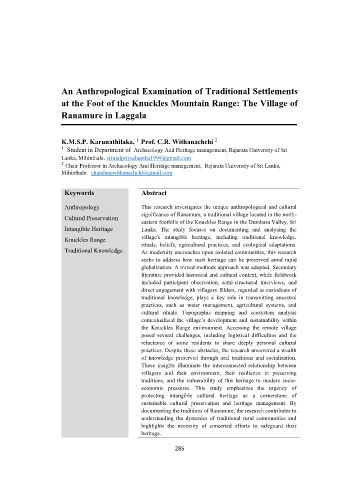Page 306 - Proceedings book
P. 306
An Anthropological Examination of Traditional Settlements
at the Foot of the Knuckles Mountain Range: The Village of
Ranamure in Laggala
1
2
K.M.S.P. Karunathilaka, Prof. C.R. Withanachchi
1 Student in Department of Archaeology And Heritage management, Rajarata University of Sri
Lanka, Mihinthale. srimalpriyashantha1999@gmail.com
2
Chair Professor in Archaeology And Heritage management, Rajarata University of Sri Lanka,
Mihinthale. chandanawithanachchi@gmail.com
Keywords Abstract
Anthropology This research investigates the unique anthropological and cultural
significance of Ranamure, a traditional village located in the north-
Cultural Preservation
eastern foothills of the Knuckles Range in the Dumbara Valley, Sri
Intangible Heritage Lanka. The study focuses on documenting and analysing the
Knuckles Range village's intangible heritage, including traditional knowledge,
rituals, beliefs, agricultural practices, and ecological adaptations.
Traditional Knowledge As modernity encroaches upon isolated communities, this research
seeks to address how such heritage can be preserved amid rapid
globalization. A mixed-methods approach was adopted. Secondary
literature provided historical and cultural context, while fieldwork
included participant observation, semi-structured interviews, and
direct engagement with villagers. Elders, regarded as custodians of
traditional knowledge, plays a key role in transmitting ancestral
practices, such as water management, agricultural systems, and
cultural rituals. Topographic mapping and ecosystem analysis
contextualized the village’s development and sustainability within
the Knuckles Range environment. Accessing the remote village
posed several challenges, including logistical difficulties and the
reluctance of some residents to share deeply personal cultural
practices. Despite these obstacles, the research uncovered a wealth
of knowledge preserved through oral traditions and socialization.
These insights illuminate the interconnected relationship between
villagers and their environment, their resilience in preserving
traditions, and the vulnerability of this heritage to modern socio-
economic pressures. This study emphasizes the urgency of
protecting intangible cultural heritage as a cornerstone of
sustainable cultural preservation and heritage management. By
documenting the traditions of Ranamure, the research contributes to
understanding the dynamics of traditional rural communities and
highlights the necessity of concerted efforts to safeguard their
heritage.
285

